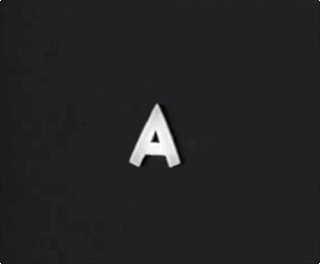
A Movie is a 1958 experimental collage film by American artist Bruce Conner. It combines pieces of found footage taken from various sources such as newsreels, soft-core pornography, and B movies, all set to a score featuring Ottorino Respighi's Pines of Rome.
Peter Barrington Hutton was an American experimental filmmaker, known primarily for his silent cinematic portraits of cities and landscapes around the world. He also worked as a professional cinematographer, most notably for his former student Ken Burns, as well as cinematography for Lizzie Borden's Born in Flames, Sheila McLaughlin and Lynne Tillman's Committed, assorted films by artist Red Grooms and Albert Maysles' The Gates.
Cosmic Ray is a 1962 American experimental short film directed by Bruce Conner. With both found footage and original material, it features images of countdown leader, a nude woman dancing, a Mickey Mouse cartoon, and military exercises. It is soundtracked by a performance of Ray Charles's "What'd I Say" and has been recognized as the first music video.

San Francisco Cinematheque is a San Francisco-based film society for artist-made cinema. It was created in 1961 by a group of filmmakers, including Bruce Baillie and Chick Strand. This screening program grew into Canyon Cinema before being split off into a sister organization, originally named the Foundation for Art in Cinema, during the 1970s.

Janis Crystal Lipzin, is an American artist and educator, working with film, photography, video, audio, multi-media installations, and media performance. Lipzin is known for her work in many media and taught at the San Francisco Art Institute for over three decades. Lipzin's films offer a unique blend of rigorous conceptual structure, formal investigation, and sensual discovery. The Bladderwort Document is a haunting visual fantasia of her life on a farm in the 1970s; Trepanations is a droll meditation on social forces and women's appearance; and Seasonal Forces, Part One creates a fluid and immediate record of the cultural and seasonal changes in the rural landscape where she lives.She has been an active filmmaker since 1974, when she became attracted to using Super-8 cameras, in part because of their easy portability and flexibility to make changes to a film up to the moment of projection. Her more recent work incorporates both digital and analog film methods. wherein light and photo-chemistry collide and conspire to reveal aspects of our world deserving of more careful scrutiny. Her work blends an enduring interest in the volatility of nature and human events with a sympathy for alternative, hand-made methods that she interweaves with digital processes. Lipzin is based in Sonoma County, California.
Hours for Jerome (1980–82) is an American silent experimental film in two parts directed by Nathaniel Dorsky recording the daily events of Dorsky and his partner, artist Jerome Hiler, around Lake Owassa in New Jersey and in Manhattan. The two films revolve around the four seasons with Part 1 revolving around spring through summer while part 2 revolves around fall through winter. According to Dorsky, he states that the film "is an arrangement of images, energies, and illuminations from daily life" and a "silent tone poem".
The 53rd New York Film Festival was held September 25 – October 11, 2015.
Schmeerguntz is a 1965 American avant-garde film by Gunvor Nelson and Dorothy Wiley. It is a collage film that contrasts messy depictions of domestic life with the pristine images of women found in media and advertising. The film was an inspiration for the Miss America protest that happened in 1968.
Curtis A. McDowell was an American underground filmmaker.

Jerome Hiler is an American experimental filmmaker, painter, and stained glass artist. Having started in New York during the New American Cinema movement, Hiler and his partner Nathaniel Dorsky moved in 1971 to San Francisco, where for many years his work was shown in the context of private salon screenings. He began to publicly screen his films in the late 1990s, releasing new films regularly since 2010. Hiler's work makes use of vivid colors, musical rhythms or structures, and layered superimpositions edited in camera.
All My Life is a 1966 American experimental short film directed by Bruce Baillie. It shows a continuous shot of a fence, soundtracked by Ella Fitzgerald's 1936 debut single "All My Life". Film critic P. Adams Sitney identified it as an early example of what he termed structural film.
Variations is a 1998 American short silent avant-garde film directed by Nathaniel Dorsky. It is the second film in a set of "Four Cinematic Songs", which also includes Triste, Arbor Vitae, and Love's Refrain.
Side/Walk/Shuttle is a 1991 American avant-garde film directed by Ernie Gehr. It shows downtown San Francisco as seen at different angles from a moving elevator.
The Arboretum Cycle is a seven-part film cycle by American experimental filmmaker Nathaniel Dorsky. The films—Elohim, Abaton, Coda, Ode, September, Monody, and Epilogue—were shot in 2017 at the Strybing Arboretum in San Francisco. Dorsky made the series to capture the interaction between light and plants in the garden.
Triste is a 1996 American avant-garde short film directed by Nathaniel Dorsky. It is the first in a set of "Four Cinematic Songs", which also includes Variations, Arbor Vitae, and Love's Refrain.
Music Makes a City is a 2010 American documentary film directed by Owsley Brown III and Jerome Hiler. It examines the history of the Louisville Orchestra.
Alaya is a 1987 American avant-garde short film directed by Nathaniel Dorsky. It shows sand filmed in different ways.
17 Reasons Why is a 1987 American avant-garde short film directed by Nathaniel Dorsky. Working with a collection of secondhand portable cameras, Dorsky used the unslit 8 mm footage to create a split screen with four quadrants. Normally screened on 16 mm film at 16 frames per second, it is one of his only works to have been shown as a digital transfer.
Pneuma is a 1983 American avant-garde short film directed by Nathaniel Dorsky. It captures grain patterns from unexposed film stocks.
The Way to Shadow Garden is a 1955 American experimental film directed by Stan Brakhage.





